The Sandy Bridge Review: Intel Core i7-2600K, i5-2500K and Core i3-2100 Tested
by Anand Lal Shimpi on January 3, 2011 12:01 AM ESTGaming Performance
There's simply no better gaming CPU on the market today than Sandy Bridge. The Core i5 2500K and 2600K top the charts regardless of game. If you're building a new gaming box, you'll want a SNB in it.
Our Fallout 3 test is a quick FRAPS runthrough near the beginning of the game. We're running with a GeForce GTX 280 at 1680 x 1050 and medium quality defaults. There's no AA/AF enabled.
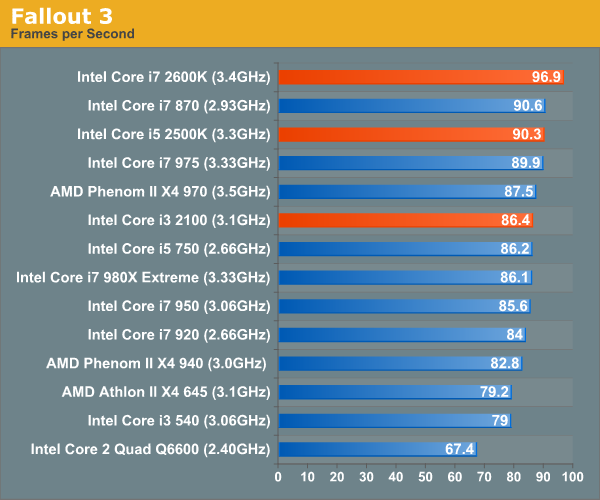
In testing Left 4 Dead we use a custom recorded timedemo. We run on a GeForce GTX 280 at 1680 x 1050 with all quality options set to high. No AA/AF enabled.

Far Cry 2 ships with several built in benchmarks. For this test we use the Playback (Action) demo at 1680 x 1050 in DX9 mode on a GTX 280. The game is set to medium defaults with performance options set to high.
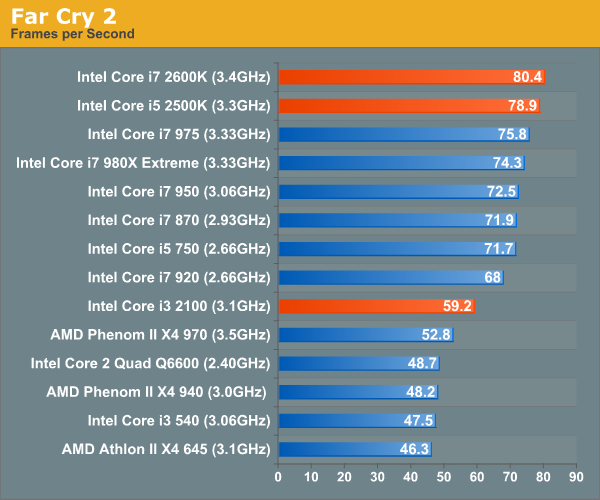
Crysis Warhead also ships with a number of built in benchmarks. Running on a GTX 280 at 1680 x 1050 we run the ambush timedemo with mainstream quality settings. Physics is set to enthusiast however to further stress the CPU.
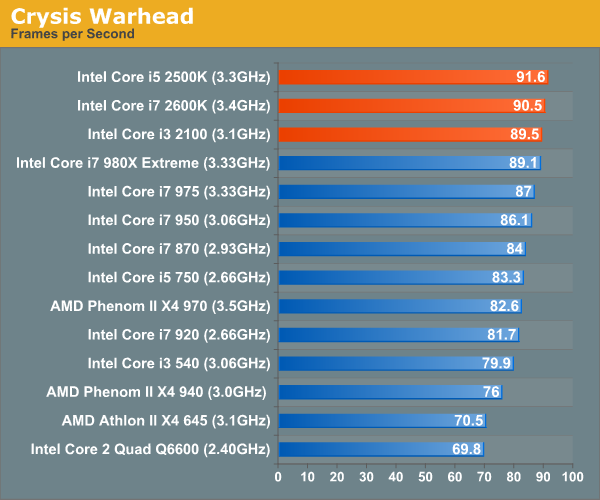
Our Dragon Age: Origins benchmark begins with a shift to the Radeon HD 5870. From this point on these games are run under our Bench refresh testbed under Windows 7 x64. Our benchmark here is the same thing we ran in our integrated graphics tests - a quick FRAPS walkthrough inside a castle. The game is run at 1680 x 1050 at high quality and texture options.
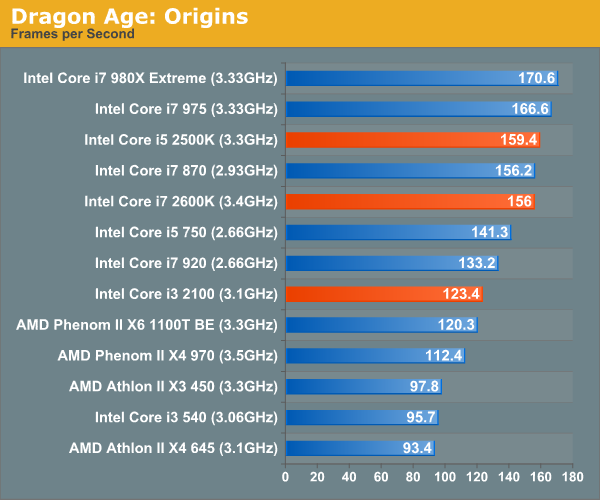
We're running Dawn of War II's internal benchmark at high quality defaults. Our GPU of choice is a Radeon HD 5870 running at 1680 x 1050.
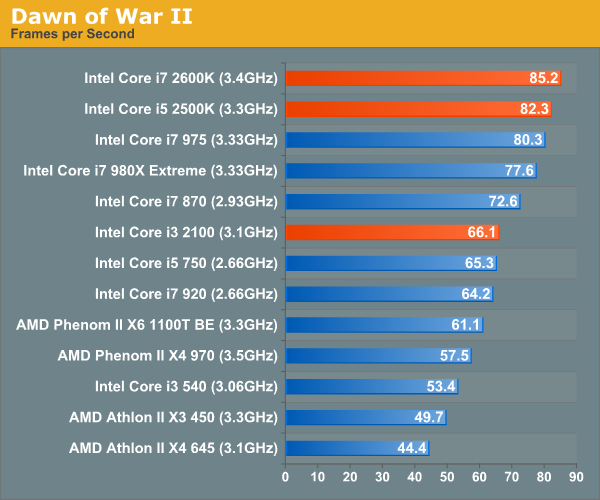
Our World of Warcraft benchmark is a manual FRAPS runthrough of a lightly populated server with no other player controlled characters around. The frame rates here are higher than you'd see in a real world scenario, but the relative comparison between CPUs is accurate.
We run on a Radeon HD 5870 at 1680 x 1050. We're using WoW's high quality defaults but with weather intensity turned down all the way.
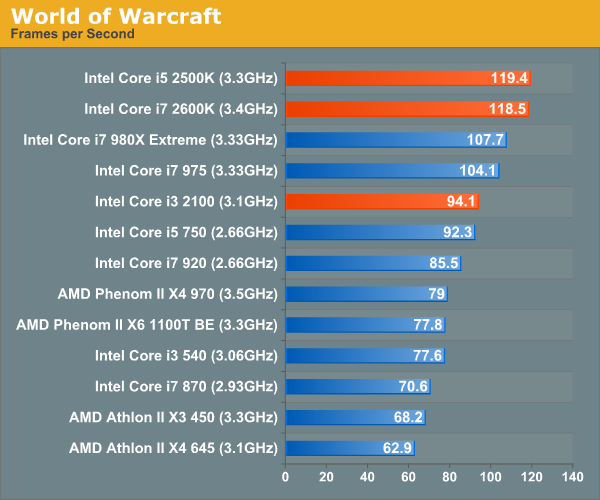
For Starcraft II we're using our heavy CPU test. This is a playback of a 3v3 match where all players gather in the middle of the map for one large, unit-heavy battle. While GPU plays a role here, we're mostly CPU bound. The Radeon HD 5870 is running at 1024 x 768 at medium quality settings to make this an even more pure CPU benchmark.
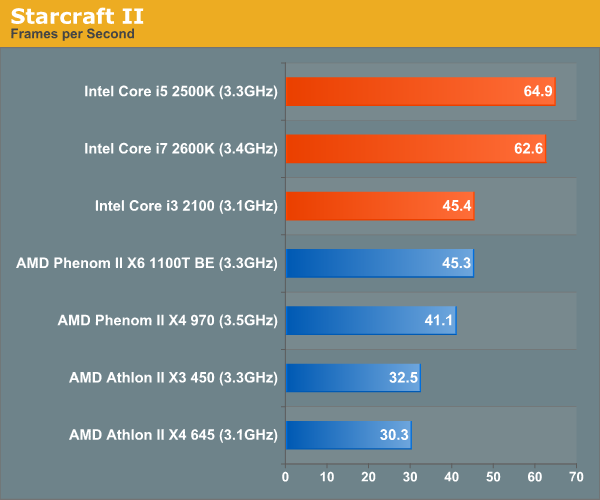
This is Civ V's built in Late GameView benchmark, the newest addition to our gaming test suite. The benchmark outputs three scores: a full render score, a no-shadow render score and a no-render score. We present the first and the last, acting as a GPU and CPU benchmark respectively.
We're running at 1680 x 1050 with all quality settings set to high. For this test we're using a brand new testbed with 8GB of memory and a GeForce GTX 580.
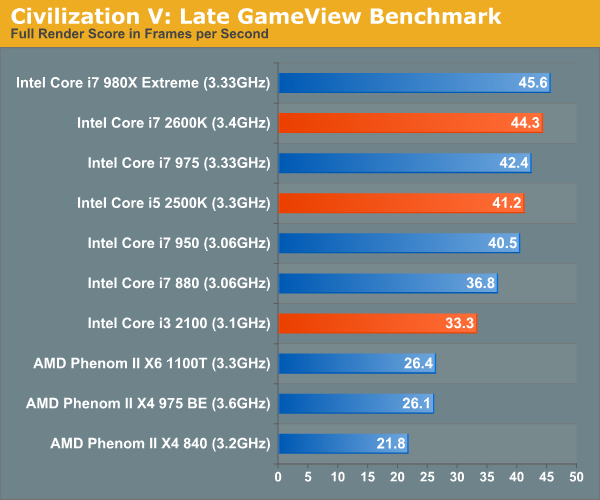
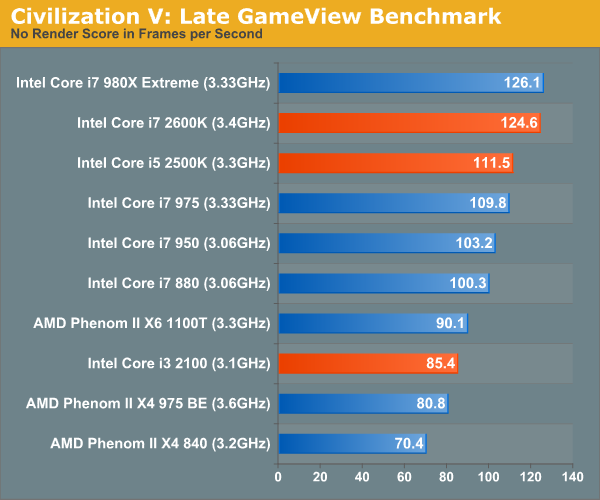










283 Comments
View All Comments
hmcindie - Monday, January 3, 2011 - link
Why is that Quick Sync has better scaling? Very evident in the Dark Knight police car image as all the other versions have definite scaling artifacts on the car.Scaling is something that should be very easy. Why is there so big a difference? Are these programs just made to market new stuff and no-one really uses them because they suck? So big scaling differences between codepaths make no sense.
JarredWalton - Monday, January 3, 2011 - link
It looks to me like some of the encodes have a sharpening effect applied, which is either good (makes text legible) or bad (aliasing effects) depending on your perspective. I'm quite happy overall with the slightly blurrier QS encodes, especially considering the speed.xxxxxl - Monday, January 3, 2011 - link
I've been so looking forward to SB...only to hear that H67 cant overclock CPU?!?!?!?!Disappointed.
digarda - Monday, January 3, 2011 - link
Who needs the IGP for a tuned-up desktop PC anyway? Some for sure, but I see the main advantages of the SB GPU for business laptop users. As the charts show, for desktop PC enthusiasts, the GPU is still woefully slow, being blown away even by the (low-end) Radeon 5570. For this reason, I can't help feeling that the vast majority of overclockers will still want to have discrete graphics.I would have preferred to dual core (4-thread) models to have (say) 32 shaders, instead of the 6 or 12 being currently offered. At 32nm, there's probably enough silicon real estate to do it. I guess Intel simply didn't want the quad core processors to have a lower graphics performance than the dual core ones (sigh).
Pity that the socket 2011 processors (without a GPU) are apparently not going to arrive for nearly a year (Q4 2011). I had previously thought the schedule was Q3 2011. Hopefully, AMD's Bulldozer-based CPUs will be around (or at least imminent) by then, forcing intel to lower the prices for its high-end parts. On the other hand, time to go - looks like I'm starting to dream again...
Exodite - Monday, January 3, 2011 - link
Using myself as an example showing the drawback of limiting overclocking on H67 would be the lack of a good selection of overclocking-friendly micro-ATX boards due to most, if not all, of those being H67.Granted, that's not Intel's fault.
It's just that I have no need for more than one PCIe x16 slot and 3 SATA (DVD, HDD, SSD). I don't need PCI, FDD, PS2, SER, PAR or floppy connectors at all.
Which ideally means I'd prefer a rather basic P67 design in micro-ATX format but those are, currently, in short supply.
The perfect motherboard, for me, would probably be a P67 micro-ATX design with the mandatory x8/x8 Crossfire support, one x1 and one x4 slot, front panel connector for USB 3, dual gigabit LAN and the base audio and SATA port options.
Gigabyte?
Anyone? :)
geofelt - Monday, January 3, 2011 - link
The only P67 based micro-ATX motherboard I have found to date is theAsus P8P67-M pro. (or evo?)
Any others?
Rick83 - Monday, January 3, 2011 - link
There's also a non-pro P8P67-M.Keep in mind though, that the over-clocking issue may not be as bad as pointed out. There are H67 boards being marketed for over-clocking ability and manuals showing how to adjust the multiplier for CPUs... I'm not yet convinced over-clocking will be disabled on H67.
smilingcrow - Monday, January 3, 2011 - link
Major bummer as I was going to order a Gigabyte H67 board and an i5-2500K but am put off now. They seem to over-clock so well and with low power consumption that it seemed the perfect platform for me…I don’t mind paying the small premium for the K editions but being forced to use a P67 and lose the graphics and have difficulty finding a mATX P67 board seems crazy!
I wonder if this limit is set in the chipset or it can be changed with a BIOS update?
DanNeely - Monday, January 3, 2011 - link
Quick Sync only works if the IGP is in use (may be fixable via drivers later); for anyone who cares about video encoding performance that makes the IGP a major feature.mariush - Monday, January 3, 2011 - link
On the Dark Knight test...Looking at the Intel software encoding and the AMD encoding, it looks like the AMD is more washed out overall, which makes me think there's actually something related to colorspaces or color space conversion involved....
Are you guys sure there's no PC/TV mixup there with the luminance or ATI using the color matrix for SD content on HD content or something like that?